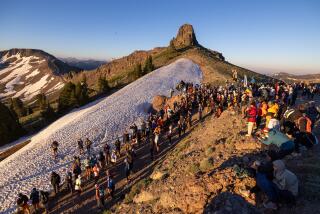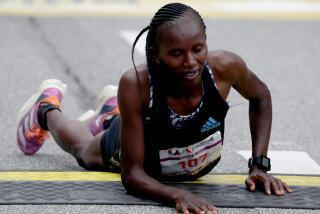In long run, it’s about journey, not destination
- Share via
After running 50 marathons in 50 days in 50 states and finishing with a creditable three-hour, 30-second race in New York on Nov. 5, Dean Karnazes was restless. So he did what he usually does when he feels the walls closing in: He took off for a run.
To San Francisco.
That’s where he lives when he’s not competing in ultra-marathons in Death Valley or marathons at the South Pole or running 350 miles continuously over 80-plus hours and three sleepless nights.
Running 3,000 miles might sound preposterous, but it makes perfect sense to him.
“I just kind of wanted to clear my head,” said Karnazes, who was born in Inglewood and grew up in Diamond Bar and San Clemente. “I’m just a guy who loves to go running in the middle of the night by myself, very unstructured.”
As spontaneously as he had set off to run home, he decided to stop Friday. When he reached St. Charles, Mo., where he had begun his 50/50/50 mission in September in the Lewis & Clark Marathon, he knew he had gone far enough.
“I had a kind of epiphany,” he said. “I missed my family and my kids so bad, and even though I saw them at Thanksgiving and thought I had gotten my fill of them, I realized I hadn’t.
“As encouraging and supportive as everyone has been throughout all of this, I wanted to be with my kids and be back in their lives.”
Traveling along back roads and highways, braving ice storms and snow, Karnazes ran nearly 1,300 miles in 28 days. That doesn’t include a hiatus in November to compete in a 24-hour race in Texas, where he ran 137.76 miles and finished fourth.
Karnazes, 44, set out from New York pushing a jogging stroller that held his gear. He slept where he could. His father, Nick, a field naturalist for the department of education in Orange County, joined him in mid-November in a 34-foot RV that provided showers and a comfortable bed.
The younger Karnazes carried a device that tracked his mileage and wrote a blog on his website, ultramarathonman.com. That helped people find him, and they often found him to wish him well or run with him for a while.
Nick Karnazes said he was touched by a couple whose son, a Harvard student, directed them to where Dean was and begged them to take pictures with him. Nick also recalled a young man he knew only as Al who insisted that Dean take his jacket and gloves to protect against chilly weather.
“I’m floating. I’m just thrilled with what’s gone on with Dean and his life,” Nick Karnazes said. “It’s been overwhelming to watch what has taken place.”
Dean’s favorite memories include his visit to a grade school in Aviston, Ill., 30 miles east of St. Louis. The kids had studied him to enliven their lessons about geography and other subjects, and they lined up to greet him when he arrived. “I had 400 kids looking at me like I was Abraham Lincoln,” he said, laughing.
Since the day he turned 30 and resolved to run 30 miles despite having taken a 15-year break from the sport, Karnazes has devoted himself to running extreme distances. He has plodded along hills, trails and tracks, in temperatures ranging from minus-40 degrees at the South Pole to 127 degrees in Death Valley.
“It’s my way of exploring how far the human body can go. I won’t be satisfied until I know what I’m capable of,” he said.
His persistence and his crusade to get kids involved in physical activity have won him admirers beyond his niche sport. According to Outside magazine, 12,000 to 15,000 people in the U.S. finished an ultra-marathon in 2004, usually 50 miles, 100 miles, 50 kilometers or 100 kilometers. That year 150,000 people finished a triathlon -- running, biking and swimming -- and 423,000 finished a traditional, 26.2-mile marathon.
Karnazes, a chiseled 5 feet 8 and 156 pounds, isn’t the fastest runner. Nor is he the most successful: He has won two major events, the 2004 Badwater ultra-marathon and the Vermont 100 this year. His website says he won the running division of the inaugural South Pole marathon but doesn’t say he was alone in that division because he wore running shoes. Two other entrants wore snowshoes, and one beat him to the finish line.
Such hyperbole has fueled disparaging comments on running-centered websites. One post at letsrun.com derided him as “the Anna Kournikova of his sport,” implying that his good looks bring him undue fame. Another said Karnazes “mainly seems to compete in events with a few participants, finish fairly well, but then package together what he has done in an incredible way.”
Weldon Johnson, a former elite runner who created letsrun.com, lauded Karnazes’ frequent charity work and dedication but said many runners resent his ability to attract sponsors and fame for feats they deem less than spectacular.
“There are a lot of runners who could do what Dean does and in many cases have done it before him, they just have not received the publicity,” Johnson said. “Yet, Dean allows himself to be marketed as something he is not....
“Dean’s biggest accomplishment is not in running, but in marketing.”
John Morelock, an ultra-marathoner from Washington who has defended Karnazes at letsrun.com, said he considers Karnazes “very good, not great. He’s not a racer, just a very good performer.” He believes the Internet venom is a product of youth and unfamiliarity with ultra-running: Most top ultra-runners are at least 35 because it takes years to build the required stamina, but most message-board posters are younger.
“Some people associate ultra-running with casual running. There’s still legitimate athletic effort in covering 50 miles or 100 miles. And there’s mental effort too,” Morelock said. “People who don’t run ultras don’t understand the endurance aspect after three to five hours.... If he gets some people up to run three miles or five miles or 50 miles, great. I’d like to think he draws positive publicity for running.”
Karnazes said he no longer pays attention to criticism and instead focuses on “the hundreds of e-mails from people around the world who say they’ve been inspired by what I do.”
Those people will see him run again, though he’s not sure when the impulse will strike or how far it will carry him.
“I know there’s going to be something next and it’s going to involve offering to have others join me,” he said. “That makes running a lot more fulfilling than a solo pursuit.”
More to Read
Sign up for The Wild
We’ll help you find the best places to hike, bike and run, as well as the perfect silent spots for meditation and yoga.
You may occasionally receive promotional content from the Los Angeles Times.







